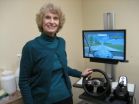(Press-News.org) LOS ANGELES (March 10, 2014) – A team of researchers from the National Institutes of Health, Emory University and Cedars-Sinai – specialists in identifying and treating very rare diseases – used three innovative tools to detect a previously unknown gene mutation, test potential therapies in the lab, and initiate personalized drug treatment for a boy with a lifelong history of uncontrollable seizures that caused significant impact on his cognitive and social development.
"This personalized medical approach exemplifies the power of current research tools and shows the immense potential of applying these technologies for future patients," said Tyler Mark Pierson, MD, PhD, a pediatric neurologist and member of the Department of Pediatrics and the Department of Neurology at Cedars-Sinai. Pierson, a member of the research faculty at the Cedars-Sinai Regenerative Medicine Institute, is first author of an article in Annals of Clinical and Translational Neurology that published online March 3 ahead of print.
Pierson was a member of the National Institutes of Health's Undiagnosed Diseases Program when he was introduced to the patient and his family. The child was first seen at the NIH-UDP when he was 6; he was diagnosed with early-onset epileptic encephalopathy of unknown etiology. The patient had experienced treatment-resistant seizures since 3 months of age, which caused significant issues with brain development resulting in global developmental delay. The NIH-UDP is a program of NIH's National Human Genome Research Institute (NHGRI), Office of Rare Diseases Research, and Clinical Center.
The researchers identified a "de novo" gene mutation – one that occurs for the first time in a member of a family – in a gene called GRIN2A. The discovery required an analysis of the patient's genetic makeup in search of the one gene that changed, setting this detrimental series of events in motion. Pierson and his colleagues at the NIH-UDP and Emory University used a recently developed technique called exome sequencing, which focuses on this "functional" part of the genome. They further employed a unique set of data bases and "filters" to streamline their search and screen out false positive results, which are fairly common with new-generation technology that rapidly analyzes thousands of genetic sequences.
"Genome-scale sequencing is a powerful new tool in medical diagnostics. The data it returns, however, can be challenging to interpret, especially for ultra-rare disorders. The rapid bench-to-bedside story of the GRIN2A variation in this family is an example of the coalescence of expertise in medicine, medical genomics and basic science around a single child. This is the type of collaboration that will be needed in an age where we will struggle to connect vast data-collecting capability with the health of individual people," said David Adams, MD, PhD, pediatrician and biochemical geneticist at NHGRI.
Pierson added that many other genes have been associated with several forms of epilepsy in infancy, but only few other instances of early-onset epileptic encephalopathy involved the GRIN2A gene. The GRIN2A gene influences electrochemical events that affect the flow and strength of electrical impulses in the brain.
Having identified the de novo gene defect, the researchers conducted laboratory experiments to confirm the resulting protein dysfunction and its effects on electrical-regulating mechanisms.
"We then performed lab studies with several drugs that were already approved by the Food and Drug Administration and which we thought might block the seizure activity. Memantine, a drug developed to treat Alzheimer's disease, was shown to have some effect. This medication was previously found to have anticonvulsant effects in animal models of epilepsy and has been safely used in children with autism," said Hongjie Yuan, MD, PhD, scientist in the Department of Pharmacology at the Emory University School of Medicine.
Based on the lab studies, memantine gradually was added to the patient's regimen, which included three anti-seizure drugs that had provided little or no control. With memantine, the number of seizures dropped dramatically, and two of the drugs were discontinued.
"We believe this GRIN2A mutation initiated changes in the child's brain that led to intractable seizures, which contributed to his poor development and cognitive deficits," Pierson said. "It is conceivable that earlier intervention of this personalized medicine approach could have altered the course of the disorder and possibly the child's neurological development. Our results suggest that children with early-onset epileptic encephalopathy should undergo evaluation for similar gene variants, with the possibility of using memantine or other anti-seizure medications to reduce long-term effects."
Pierson has continued his work with rare undiagnosed neurogenetic diseases at Cedars-Sinai with the Pediatric Neurogenetics and Neuromuscular Clinic and his laboratory in the Regenerative Medicine Institute. Pierson was also a co-author on a recent article published in Nature Communications by his Emory University and NIH colleagues that provides a more thorough description of how the GRIN2A mutation results in epilepsy.
INFORMATION:
Sixteen authors, including William A. Gahl, MD, PhD, clinical director, NHGRI, contributed to the journal article. Several of the researchers were supported by the NIH-UDP. Support also came from NIH-NINDS (NS036654) and the Cedars-Sinai Diana and Steve Marienhoff Fashion Industries Guild Endowed Fellowship in Pediatric Neuromuscular Disorders. The authors say no potential conflicts of interest exist.
Citation: Annals of Clinical and Translational Neurology. "GRIN2A mutation and epileptic encephalopathy: personalized therapy with memantine." Published online March 3. http://onlinelibrary.wiley.com/doi/10.1002/acn3.39/abstract
Detecting, testing, treating rare diseases: Technology delivers new era of personalization
2014-03-11
ELSE PRESS RELEASES FROM THIS DATE:
Study using driving simulator determines when it's safe to drive after hip replacement
2014-03-11
After hip replacement surgery, many patients are anxious to resume driving, and a new study challenges the conventional wisdom that patients should wait six weeks before getting back behind the wheel. Dr. Geoffrey Westrich, director of research, Adult Reconstruction and Joint Replacement at Hospital for Special Surgery in New York City, found that patients in the study were able to return to driving four weeks after total hip replacement.
The study, titled, "A Novel Assessment of Driving Reaction Time Following THR Using a New Fully Interactive Driving Simulator," will ...
New MRI can 'see through' metal screws to follow patients after hip fracture surgery
2014-03-11
People who sustain the most common type of hip fracture, known as a femoral neck fracture, are at increased risk of complications. A special type of MRI developed at Hospital for Special Surgery in collaboration with GE Healthcare can show a detailed image following fracture repair, without the distortion caused by metal surgical screws that are problematic in standard MRIs.
Each year, more than 340,000 people suffer a broken hip in the United States. The femoral neck, the area just below the ball of the hip's ball-and-socket joint, is the most common site of fracture, ...
Study: Women report more pain than men after knee replacement surgery
2014-03-11
Middle-aged women with rheumatoid arthritis or arthritis resulting from an injury are among the patients most likely to experience serious pain following a knee replacement, researchers from Hospital for Special Surgery (HSS) in New York have found.
One of the biggest concerns patients have is the amount of pain they will have after knee replacement surgery. Although it is a very successful operation overall to relieve arthritis pain and restore function, persistent postoperative pain can be a problem for some patients. Researchers at HSS set out to determine which groups ...
Personality may be key risk factor in preventive health care
2014-03-11
WASHINGTON – When it comes to helping young adults avoid serious health problems later in life, assessing their personalities during routine medical exams could prove as useful as recording their family medical histories and smoking habits, according to new research published by the American Psychological Association.
"Health care reform provides a great opportunity for preventive care, with physicians seeing more young adults who may not previously have had insurance," said lead author Salomon Israel, PhD, of Duke University and Duke University Medical Center. "Our research ...
UGA researchers identify decision-making center of brain
2014-03-11
Athens, Ga. – Although choosing to do something because the perceived benefit outweighs the financial cost is something people do daily, little is known about what happens in the brain when a person makes these kinds of decisions. Studying how these cost-benefit decisions are made when choosing to consume alcohol, University of Georgia associate professor of psychology James MacKillop identified distinct profiles of brain activity that are present when making these decisions.
"We were interested in understanding how the brain makes decisions about drinking alcohol. Particularly, ...
A new cell type is implicated in epilepsy caused by traumatic brain injury
2014-03-11
BOSTON (March 11, 2014) — Traumatic brain injury is a risk factor for epilepsy, though the relationship is not understood. A new study in mice, published in Cerebral Cortex, identifies increased levels of a specific neurotransmitter as a contributing factor connecting traumatic brain injury (TBI) to post-traumatic epilepsy. The findings suggest that damage to brain cells called interneurons disrupts neurotransmitter levels and plays a role in the development of epilepsy after a traumatic brain injury.
The research team, led by David Cantu and Chris Dulla, studied the ...
Scientists unlock potential heart attack drug without side effects
2014-03-11
Melbourne scientists are a step closer to creating a new drug to stop a heart attack in its tracks and reduce the damage caused, without any side effects.
The Monash University research, published today in the journal, Proceedings of the National Academy of Sciences, USA (PNAS), offers new hope to thousands of people who experience heart attacks and heart failure – one of the major causes of death worldwide.
Professors Arthur Christopoulos and Peter Scammells from the Monash Institute of Pharmaceutical Sciences (MIPS) led a team of scientists combining molecular pharmacology ...
Researchers show that bold baboons learn to solve tasks from other baboons
2014-03-11
Baboons learn from other baboons about new food sources – but only if they are bold or anxious – according to a new study published in the journal PeerJ). The results suggest that personality plays a key role in social learning in animals, something previously ignored in animal cognition studies.
Studying animals at the Zoological Society of London's Institute of Zoology Tsaobis Baboon Project in Namibia, the researchers examined how personality influenced whether baboons solved foraging tasks and whether they then demonstrated to others how to solve the tasks. They found ...
Plaques detected in brain scans forecast cognitive impairment
2014-03-11
DURHAM, N.C. -- Brain imaging using radioactive dye can detect early evidence of Alzheimer's disease that may predict future cognitive decline among adults with mild or no cognitive impairment, according to a 36-month follow-up study led by Duke Medicine.
The national, multicenter study confirms earlier findings suggesting that identifying silent beta-amyloid plaque build-up in the brain could help guide care and treatment decisions for patients at risk for Alzheimer's. The findings appeared online March 11, 2014, in Molecular Psychiatry, a Nature Publishing Group journal.
"Our ...
Obesity associated with lower academic attainment in teenage girls, says new study
2014-03-11
Obesity in adolescent girls is associated with lower academic attainment levels throughout their teenage years, a new study has shown.
The research conducted by the Universities of Strathclyde, Dundee, Georgia and Bristol is the most comprehensive study yet carried out into the association between obesity and academic attainment in adolescence. The results are published in the International Journal of Obesity.
The results showed that girls who were obese, as measured by BMI (body mass index) at age 11 had lower academic attainment at 11, 13 and 16 years when compared ...

